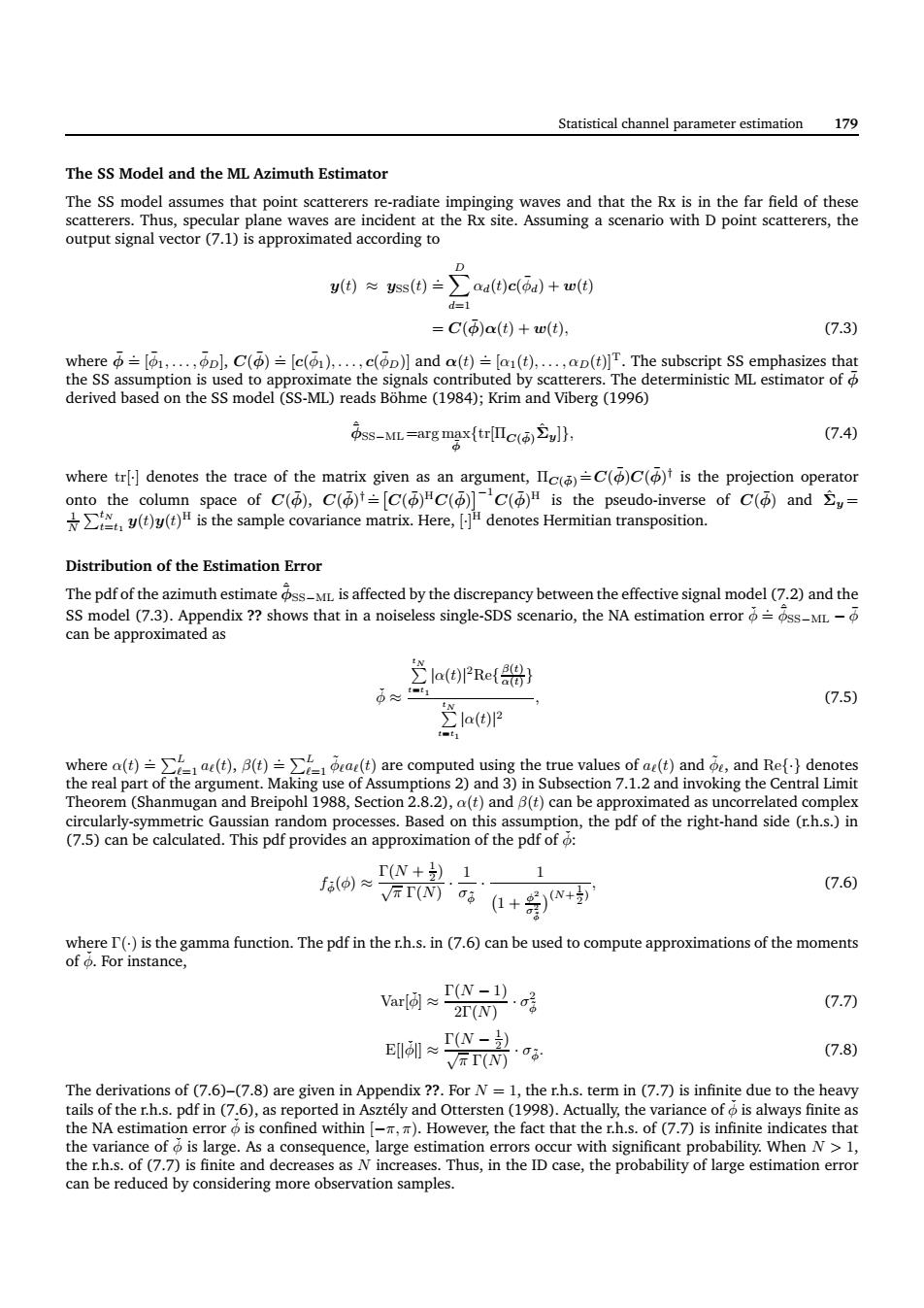正在加载图片...

Statistical channel parameter estimation 179 The Ss Model and the ML Azimuth Estimato The SS model assumes that approx ding to ≈s=oaa)+ =C()a(+w() 7.3) ,p,C()=c(⊙1) derived based on the ss model (SS-ML)reads Bohme(19):krim and Viberg(1) ss-ML-arg max(ur[c() 7.4) where tr denotes the trace of the matrix given as an argument,Ic=C()C()t is the projection operator onto the column space of C(),C()=[C()#C(]C()is the pseudo-inverse of C()and t)()is the sample covariance matrix.Here,denotes Hermitian transposition. Distribution of the Estimation Error ected by ss model (7.3).A can be approximated as 7.5) ote 0=+ (N+ 7.6 The pfin thehn()can be ued toomuteapio of theom T(N-1) 2r(N) 7.7刀 (7.8) The derivations of (7.6)-(7.8)are given in Appendix??.For N=1,the r.h.s.term in (7.7)is infinite due to the heavy n Asztely and Ottersten(1998).Actually,the va riance of is alw ys finite the r.h.s.of (.7)is finite e and decrea as N incre Thus,in the ID case,the probability of large estimation error can be reduced by considering more observation samples. Statistical channel parameter estimation 179 The SS Model and the ML Azimuth Estimator The SS model assumes that point scatterers re-radiate impinging waves and that the Rx is in the far field of these scatterers. Thus, specular plane waves are incident at the Rx site. Assuming a scenario with D point scatterers, the output signal vector (7.1) is approximated according to y(t) ≈ ySS(t) .= X D d=1 αd(t)c(φ¯ d) + w(t) = C(φ¯)α(t) + w(t), (7.3) where φ¯ .= [φ¯ 1, . . . , φ¯D], C(φ¯) .= [c(φ¯ 1), . . . , c(φ¯D)] and α(t) .= [α1(t), . . . , αD(t)]T. The subscript SS emphasizes that the SS assumption is used to approximate the signals contributed by scatterers. The deterministic ML estimator of φ¯ derived based on the SS model (SS-ML) reads Böhme (1984); Krim and Viberg (1996) φ ˆ¯ SS−ML=arg max φ¯ {tr[ΠC(φ¯)Σˆ y]}, (7.4) where tr[·] denotes the trace of the matrix given as an argument, ΠC(φ¯) .=C(φ¯)C(φ¯) † is the projection operator onto the column space of C(φ¯), C(φ¯) † .= C(φ¯) HC(φ¯) −1C(φ¯) H is the pseudo-inverse of C(φ¯) and Σˆ y = 1 N PtN t=t1 y(t)y(t) H is the sample covariance matrix. Here, [·] H denotes Hermitian transposition. Distribution of the Estimation Error The pdf of the azimuth estimate φ ˆ¯ SS−ML is affected by the discrepancy between the effective signal model (7.2) and the SS model (7.3). Appendix ?? shows that in a noiseless single-SDS scenario, the NA estimation error φˇ .= φ ˆ¯ SS−ML − φ¯ can be approximated as φˇ ≈ PtN t=t1 |α(t)| 2Re{ β(t) α(t) } PtN t=t1 |α(t)| 2 , (7.5) where α(t) .= PL ℓ=1 aℓ(t), β(t) .= PL ℓ=1 φ˜ ℓaℓ(t) are computed using the true values of aℓ(t) and φ˜ ℓ, and Re{·} denotes the real part of the argument. Making use of Assumptions 2) and 3) in Subsection 7.1.2 and invoking the Central Limit Theorem (Shanmugan and Breipohl 1988, Section 2.8.2), α(t) and β(t) can be approximated as uncorrelated complex circularly-symmetric Gaussian random processes. Based on this assumption, the pdf of the right-hand side (r.h.s.) in (7.5) can be calculated. This pdf provides an approximation of the pdf of φˇ: fφˇ(φ) ≈ Γ(N + 1 2 ) √ π Γ(N) · 1 σφ˜ · 1 1 + φ 2 σ 2 φ˜ (N+ 1 2 ) , (7.6) where Γ(·) is the gamma function. The pdf in the r.h.s. in (7.6) can be used to compute approximations of the moments of φˇ. For instance, Var[φˇ] ≈ Γ(N − 1) 2Γ(N) · σ 2 φ˜ (7.7) E[|φˇ|] ≈ Γ(N − 1 2 ) √ π Γ(N) · σφ˜. (7.8) The derivations of (7.6)–(7.8) are given in Appendix ??. For N = 1, the r.h.s. term in (7.7) is infinite due to the heavy tails of the r.h.s. pdf in (7.6), as reported in Asztély and Ottersten (1998). Actually, the variance of φˇ is always finite as the NA estimation error φˇ is confined within [−π, π). However, the fact that the r.h.s. of (7.7) is infinite indicates that the variance of φˇ is large. As a consequence, large estimation errors occur with significant probability. When N > 1, the r.h.s. of (7.7) is finite and decreases as N increases. Thus, in the ID case, the probability of large estimation error can be reduced by considering more observation samples.��